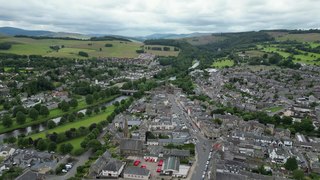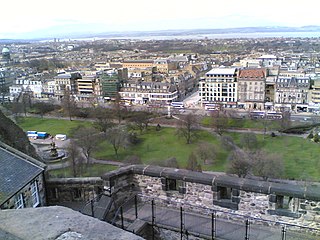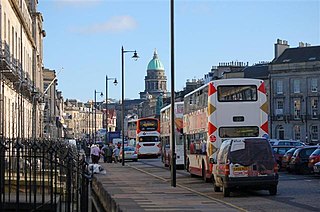Related Research Articles

The Scottish Borders is one of 32 council areas of Scotland. It is bordered by West Lothian, Edinburgh, Midlothian, and East Lothian to the north, the North Sea to the east, Dumfries and Galloway to the south-west, South Lanarkshire to the west, and the English ceremonial counties of Cumbria and Northumberland to the south. The largest settlement is Galashiels, and the administrative centre is Newtown St Boswells.

The National Garden Scheme opens privately owned gardens in England, Northern Ireland, Wales, and the Channel Islands on selected dates for charity. It was founded in 1927 with the aim of "opening gardens of quality, character and interest to the public for charity". The scheme has raised over £67 million since it began, and normally opens over 3,500 gardens a year.

Peebles is a town in the Scottish Borders, Scotland. It was historically a royal burgh and the county town of Peeblesshire. According to the 2011 census, the population was 8,376 and the estimated population in June 2018 was 9,000.
The Royal Incorporation of Architects in Scotland (RIAS) is the professional body for architects in Scotland.

Marie Curie is a registered charitable organisation in the United Kingdom which provides hospice care and support for anyone with an illness they’re likely to die from, and those close to them, and campaigns for better support for dying people. It was established in 1948, the same year as the National Health Service (NHS).

The New Town is a central area of Edinburgh, the capital of Scotland. It was built in stages between 1767 and around 1850, and retains much of its original neo-classical and Georgian period architecture. Its best known street is Princes Street, facing Edinburgh Castle and the Old Town across the geological depression of the former Nor Loch. Together with the West End, the New Town was designated a UNESCO World Heritage Site alongside the Old Town in 1995. The area is also famed for the New Town Gardens, a heritage designation since March 2001.

Inverleith is an inner suburb in the north of Edinburgh, Scotland, on the fringes of the central region of the city. Its neighbours include Trinity to the north and the New Town to the south, with Canonmills at the south-east and Stockbridge at the south-west.

Sir Robert Stodart Lorimer, KBE was a prolific Scottish architect and furniture designer noted for his sensitive restorations of historic houses and castles, for new work in Scots Baronial and Gothic Revival styles, and for promotion of the Arts and Crafts movement.

Garden tourism is a type of niche tourism involving visits to famous gardens and botanical gardens and places which are significant in the history of gardening. Garden tourists often travel individually in countries with which they are familiar but often prefer to join organized garden tours in countries where they might experience difficulties with language, travel or finding accommodation in the vicinity of the garden. In the year 2000 the Alhambra and the Taj Mahal both received over two million visitors. This poses problems for the landscape manager.

Broughton is an ancient feudal barony, today an area of Edinburgh, Scotland.

Broughton Castle is a medieval fortified manor house in the village of Broughton, which is about two miles south-west of Banbury in Oxfordshire, England, on the B4035 road. It is the home of the Fiennes family, Barons Saye and Sele. The castle sits on an artificial island in pastureland and is surrounded by a wide moat. Across the small bridge lies the parish church of St Mary the Virgin, surrounded by its historic cemetery. A Grade I listed building, it opens to the public during the summer.
Sir Lewis Bellenden of Auchnole and Broughton was a Scottish lawyer, who succeeded his father as Lord Justice Clerk on 15 March 1577.
The Queen's Nursing Institute (QNI) is a charity that works to improve the nursing care of people in their own homes in England, Wales, and Northern Ireland. It does not operate in Scotland, where the Queen's Nursing Institute Scotland performs a similar function. The QNI is also affiliated to the Queen's Institute of District Nursing in Ireland. The QNI is a member of the International Council of Nurses.

Dumfries House is a Palladian country house in Ayrshire, Scotland. It is located within a large estate, around two miles (3 km) west of Cumnock. Noted for being one of the few such houses with much of its original 18th-century furniture still present, including specially commissioned Thomas Chippendale pieces, the house and estate is now owned by The Prince's Foundation, a charity which maintains it as a visitor attraction and hospitality and wedding venue. Both the house and the gardens are listed as significant aspects of Scottish heritage.

West Linton is a village and civil parish in southern Scotland, on the A702. It was formerly in the county of Peeblesshire, but since local government re-organisation in the mid-1990s it is now part of Scottish Borders. Many of its residents are commuters, owing to the village's proximity to Edinburgh, which is 16 miles (26 km) to the north-east. West Linton has a long history, and holds an annual traditional festival called The Whipman Play.
Riccarton is a village and parish in East Ayrshire, Scotland. It lies across the River Irvine from Kilmarnock, this river forming the boundary between Riccarton and Kilmarnock parishes, and also between the historical districts of Kyle and Cunningham. The name is a corruption of 'Richard's town', traditionally said to refer to Richard Wallace, the uncle of Sir William Wallace. The parish also contains the village of Hurlford.

The West End is an affluent district of Edinburgh, Scotland, which along with the rest of the New Town and Old Town forms central Edinburgh, and Edinburgh's UNESCO World Heritage Site. The area boasts several of the city's hotels, restaurants, independent shops, offices and arts venues, including the Edinburgh Filmhouse, Edinburgh International Conference Centre and the Caledonian Hotel. The area also hosts art festivals and crafts fairs.

Gardening in Scotland, the design of planned spaces set aside for the display, cultivation, and enjoyment of plants and other forms of nature in Scotland began in the Middle Ages.
The Queen's Nursing Institute Scotland (QNIS) is a charity which promotes high quality community nursing. Based in Edinburgh, the body was founded in 1889 with the opening of the small Central Training Home at North Charlotte Street. Due to the high demand for training for district nurses, the QNIS soon moved to the grand premises at Castle Street, where it remains.

The following outline is provided as an overview of and topical guide to Edinburgh: